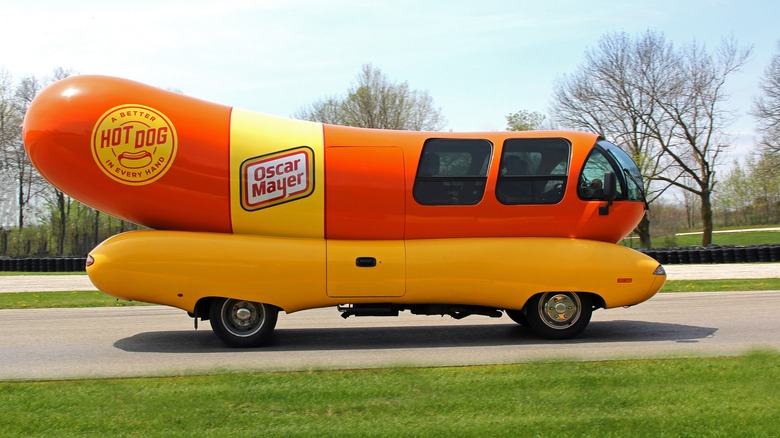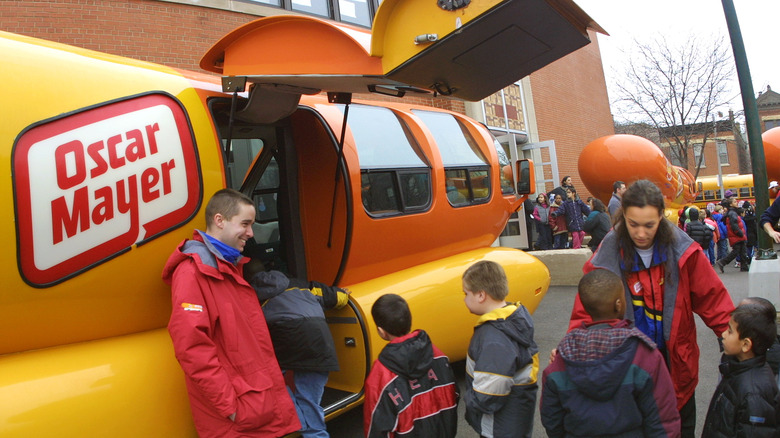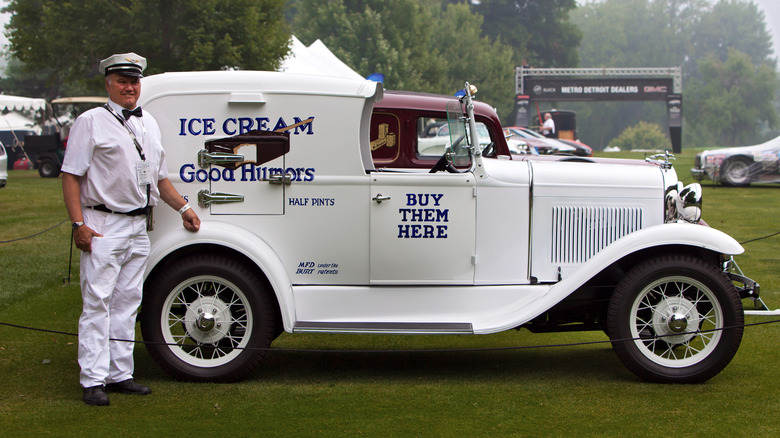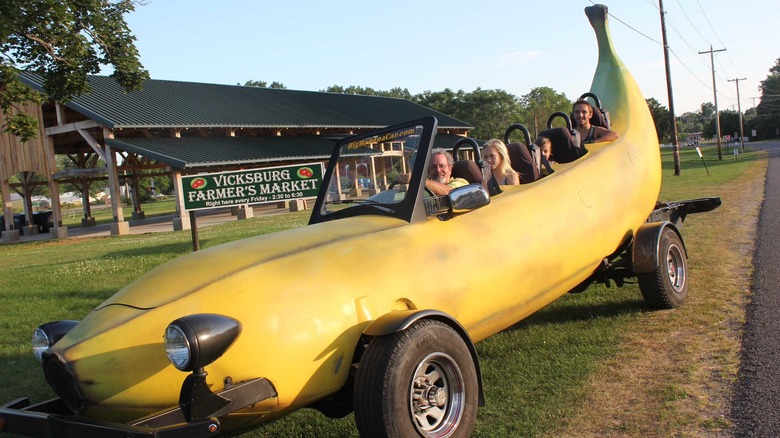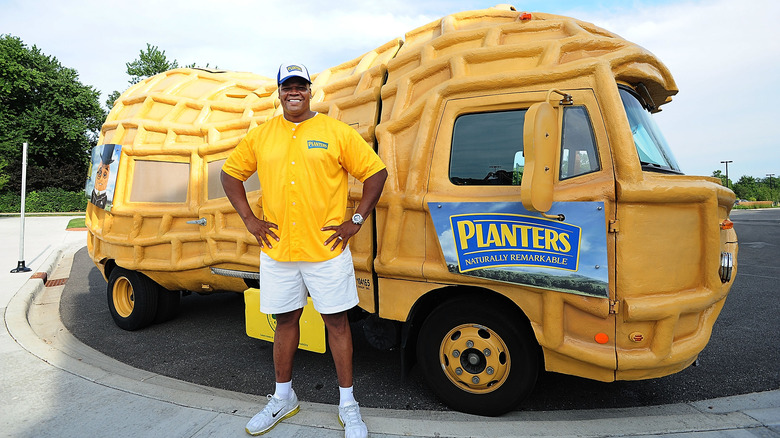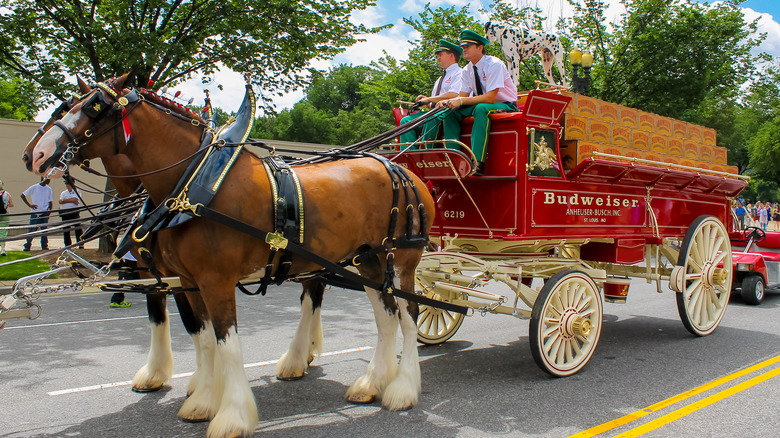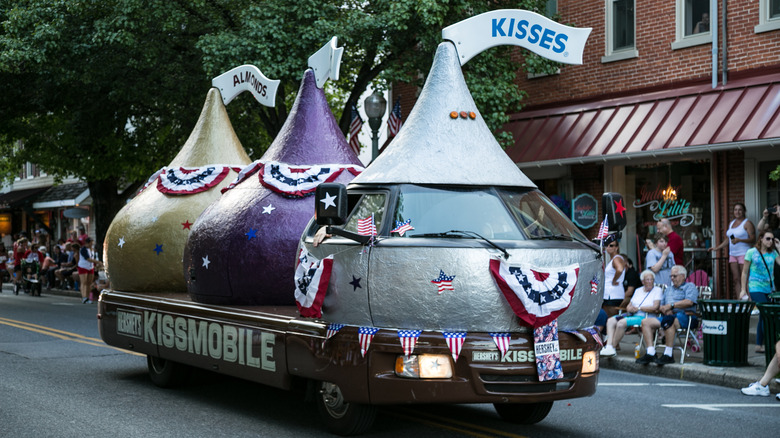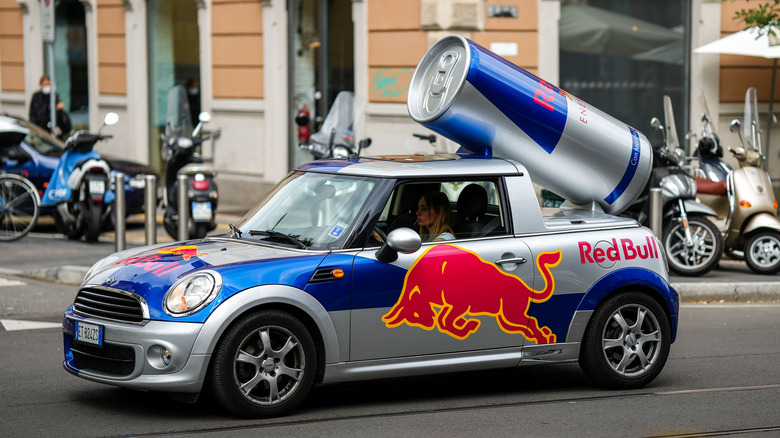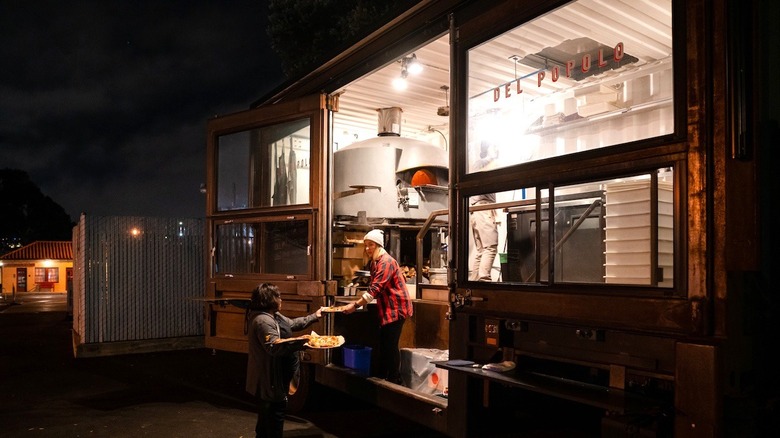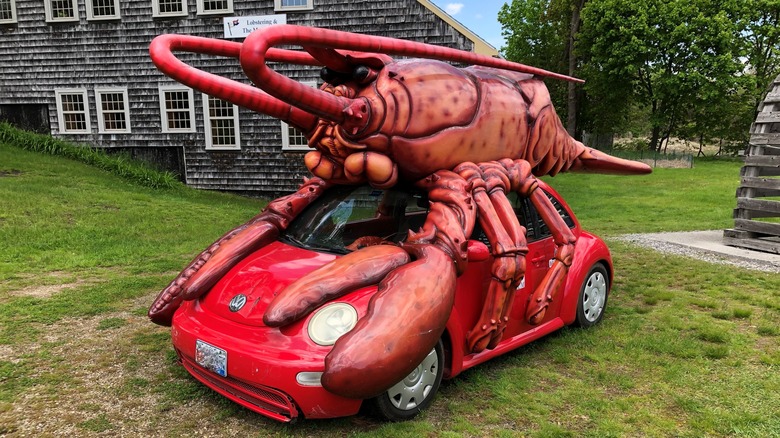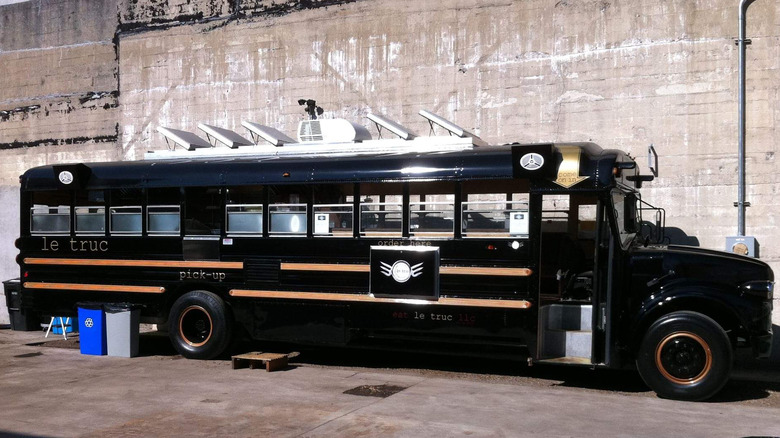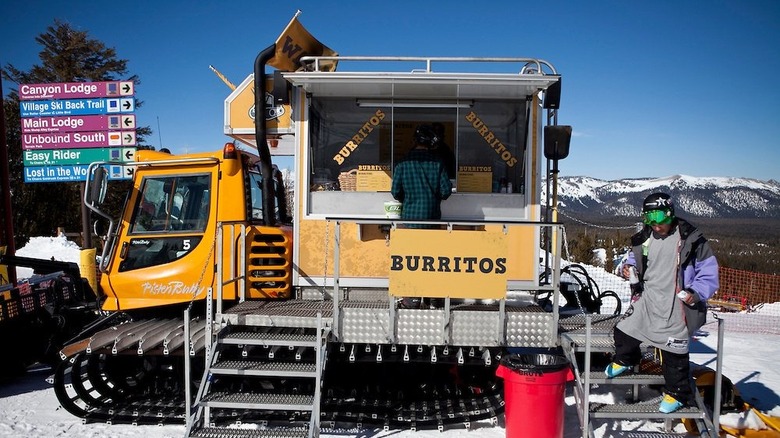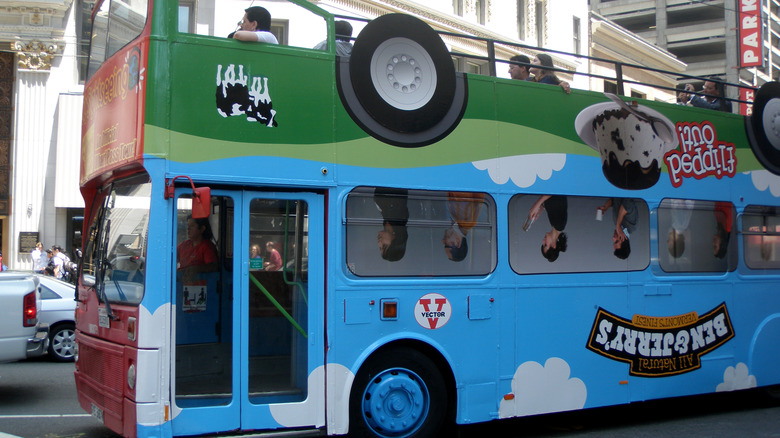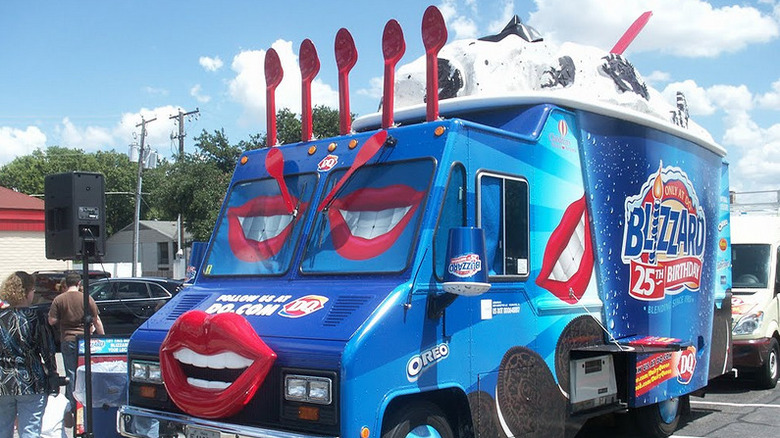The Story Behind Oscar Mayer's Wienermobile And Other Popular Food Vehicles
Correction 2/27/23: This article has been updated to reflect that Planters is now owned by Hormel Foods.
In a world of mainly boring vehicles, it's always a treat to encounter an out-of-the-ordinary food vehicle. The absurdity of seeing an Oscar Mayer Wienermobile or a car shaped like the world's largest banana is enough to put a smile on any of our faces in the middle of an otherwise ordinary day. Even in the realm of neverending silly memes that pop up on social media, driving beside a Volkswagon Beetle with a giant lobster on top will still make you want to take out your camera.
It's obvious that themed food vehicles like the Planters NUTMobile drive around for the sake of advertising products — some even give out samples. Sadly, several of the vehicles on our list, like Good Humor ice cream trucks, are no longer in operation. However, there's still a chance to see some of these conveyances, like the Hershey's Kissmobile, in museum displays dedicated to their iconic status. Let's take a deep dive into the interesting and often weird world of unique food vehicles.
The Oscar Mayer Wienermobile
The very first Oscar Mayer Wienermobile drove down the streets of Chicago in 1936 to advertise Oscar Mayer hotdogs and has been amusing people ever since. However, the Wienermobile has had numerous incarnations over the years that have significantly changed its look from that first drive. The first Wienermobile was simply a 13-foot-long metal hotdog with open compartments for a driver and passenger. Four years later, it finally got glass windows. However, it wasn't until 1958 that the design featured a bun.
The company retired its worn-out Wienermobiles in 1977 to focus on television ads. In 1988, the company decided to make a new fleet of six 23-foot-long Wienermobiles with creature comforts like a microwave, fridge, and even a cell phone (back when most of us weren't carrying personal ones). It also played 21 versions of the famous Oscar Mayer jingle over loudspeakers for maximum earworm potential. Over the years, it's become more aerodynamic and acquired a big-screen tv as well.
Oscar Mayer currently has 10 Wienermobiles in its fleet, and an online Wienermobile locator and app can help you find the closest one. If you're a graduating college senior, you can apply for a chance to drive an Oscar Mayer Wienermobile. Having "Oscar Mayer Wienermobile driver" on your resume will certainly open up some interesting opportunities (although we're not sure what they are).
Good Humor ice cream trucks
Inspired by the Eskimo Pie, Harry Burt started making ice cream with a hard chocolate shell in the 1920s in Youngstown, Ohio. The biggest difference was that Burt's ice cream came on a stick, making it more portable. Knowing he had a winning concept, he decided he needed a fleet of ice cream trucks to sell the treats. The original 12 Good Humor ice cream trucks were Model T Fords, outfitted with freezers to keep the ice cream cold and bobsled bells to alert potential customers.
The company was even profitable during the Great Depression because it offered an affordable treat. Not only were there Good Humor trucks during that time, but you could expect to see other Good Humor vehicles like bikes and hand carts around town. While the company had 2,000 trucks by 1950, the number dwindled to 1,200 in the early 1970s. By 1978, the cost of gas, upkeep for the trucks, and extra costs related to employees were causing Good Humor to lose money. The company decided it was better to ditch all the trucks and sell its ice cream in the frozen food section of grocery stores instead.
As Good Humor no longer owns ice cream trucks, the only place to find one now is at a special event or vintage automobile show. And if you happen to buy Good Humor ice cream from an ice cream truck, know that the driver purchased it from a store.
The Big Banana Car
Michigan resident Steve Braithwaite spent 2009 to 2011 building The Big Banana Car. At 22 feet and 10.5 inches long and 10 feet and two inches high, the Big Banana Car holds the Guinness World record for the world's longest custom banana car. This begs the question: Just how many people out there are building custom banana cars?
Braithwaite built his four-seater banana car on top of a 1993 Ford F-150 truck chassis. The banana itself was created from chicken wire formed into a banana shape, then covered in foam and fiberglass and painted yellow. While it only gets about 15 miles per gallon, the Big Banana Car can reach speeds up to 85 miles per hour.
Braithwaite takes his banana car out on the highway and couch surfs from coast to coast. But why? Not only does the car put smiles on faces, but he uses it to help good causes. To honor his mother, he's used the car to raise $4,000 for Deep Vein Thrombosis awareness. Currently, he uses the proceeds from giving car rides to go toward children with medical issues who don't have enough insurance to cover their treatments. You can find where the Banana Car will be next on the Big Banana Car Facebook page. And coming soon? A Sub Sandwich Car.
The Planters NUTMobile
The first Planters peanut salesman to make his rounds in a peanut-shaped NUTMobile did so in 1935. The car featured Bartholomew Richard Fitzgerald-Smythe – who we now know as Mr. Peanut – sitting astride the rear.
Back in the 1990s, Planters had a Mr. Peanut Hot Rod that would show up in parades and at NASCAR events, among other celebrations. At one point, there was a whole fleet of NUTMobiles, but now there's just one active vehicle. In October 2021, one lucky person was able to rent a retired NUTMobile for the same price as a jar of peanuts ($3.59) for a nutty RV-like camping experience in the woods.
Planters occasionally looks for drivers for its NUTMobile, so keep your eyes on the Hormel Foods job board for openings if piloting the NUTMobile is your dream job. The current NUTMobile looks like a peanut-shaped RV. It's 26 feet long, 11.5 feet wide, and can reach up to 80 miles per hour on the highway. Planters sends its NUTMobile to fairs, festivals, and Planters factories. According to former NUTMobile driver, Danny Holton, "It takes a couple of weeks to get good at driving it, but what you're not used to is all the people honking at you" (via Los Altos Town Crier).
The Budweiser Clydesdale beer wagon
While you may have seen the majestic Budweiser Clydesdale horses in Super Bowl commercials, holiday commercials, or the Rose Parade, you probably don't know their origins. The first ones were a present from Budweiser's CEO's two sons to celebrate the 1933 end of Prohibition.
The company decided that there was no better way to use the Clydesdales than to hitch to a beer wagon and deliver crates of Budweiser beer to some of the politicians who had been instrumental in helping to end Prohibition, such as Governor Alfred Smith of New York and President Franklin D. Roosevelt in Washington, D.C. These deliveries were only a small part of the tour the horses undertook, drawing crowds wherever they went.
In 1950, the Clydesdales got their own Dalmatian dog mascot as a part of the opening ceremonies for the Newark, New Jersey, brewery. Before Dalmatians become popular as fire dogs, their jobs involved protecting horse-drawn carriages. For Budweiser, that included protecting against any thirsty beer bandits during delivery. Budweiser currently has over 200 Clydesdale horses around the country, which are used for promotions and parades. Whenever you catch a glimpse of the Clydesdales, there's almost always a Dalmatian guarding the beer in the old-fashioned wagon.
The Hershey's Kissmobile
Hershey's first Kissmobile hit the roads along the east coast of the U.S. in 1997 to help celebrate the 90th anniversary of the Hershey's Kiss. One of three gigantic Hershey's Kisses on the Kissmobile was refrigerated for transporting easily-meltable chocolate kiss samples. When all 26 feet of this 12-foot tall vehicle came rumbling by, people would surely hope it would stop to satisfy their immediate chocolate cravings.
Hershey's sent the Kissmobile on a journey of over 250,000 miles, where it provided over two million samples on its tour. The Kissmobile showered people with kisses in parades, and you could also find them at celebrations attracting large numbers of people such as state fairs. Everywhere the Kissmobile went, it helped raise money for the Children's Miracle Network, with all the donations staying within the local community.
The Hershey's Kissmobile retired in 2020. However, you can still see the original one at the AACA Museum, an antique automobile museum in Hershey, Pennsylvania.
The Red Bull MINI Cooper
If you've ever seen a MINI Cooper driving down the street with a bull painted on the side and a larger-than-life can of Red Bull energy drink on the back, it's not just a custom car from an obsessed fan. Starting in 2006, Red Bull has converted around 14 MINI Coopers into Red Bull MINI Coopers each month.
Contrary to popular belief, there's no Red Bull drink inside the giant can that adorns the car. Instead, the covered truck bed beneath the oversized Red Bull has a cooler on each side of the vehicle where the real cans of ice-cold Red Bull reside. While some of these coolers need to be filled with ice to keep the drinks cool, other vehicles have running refrigerators inside.
The drivers of the Red Bull MINI Cooper are women known as Red Bull Wings, who work in pairs to give out samples of the drink. Over 3,000 of them currently work for the company. They choose where to stop for maximum impact, don Red Bull backpacks full of the energy drinks, and interact one-on-one with potential customers. Wings may stop in places like a college campus or public parks and also host designated Red Bull events.
People from all over the world have reported seeing Red Bull MINI Coopers around town. They've been spotted seemingly everywhere from Ukraine and Austria (Red Bull's home country) to Australia and Sri Lanka.
The Del Popolo pizza truck
Sometimes, it's not what's on the outside of a food vehicle that makes it spectacular but what's on the inside. That's the case for the Del Popolo pizza food truck in San Francisco, which boasts a working wood pizza oven inside. The unique mobile kitchen was constructed from a 20-foot shipping container. Inside is a gargantuan Stefano Ferrara brick oven weighing 5,000 pounds — that's as much as a mid-sized adult male hippopotamus, for reference. It heats to around 800 degrees Fahrenheit, making it possible to produce a wood-fired Neapolitan pizza in just a single minute.
The owner of the pizza truck, Jon Darsky, was a pizza maker for Pizzeria Delfino and Flour + Water before he decided to turn a Freightliner M2 truck and a shipping container into a pizzeria in 2012. The truck ended up costing $180,000 to build: $10,000 for the oven, $50,000 for labor, $80,000 for design and engineering, $17,000 for the truck, and $10,000 for custom windows that open out to 39 feet. Darsky said that part of the cost was his $2,000 commercial driver's license, making him the only person who could drive it.
Considering the hefty price tag, you may be unsurprised to learn that the truck is currently not in operation. However, you can still pick up Del Popolo pizza at the sit-down restaurant, which opened in 2015.
Boston Lobster Feast Lobstermobile
While you might expect a giant lobster car in Maine, the Lobstermobile actually calls Florida home. That's because the Boston Lobster Feast restaurant in Orlando has been putting giant lobsters atop vehicles for years. The first ones sat on pickup trucks, but when the Volkswagon Beetle made its return in 1998, the restaurant bought one to haul around a new 800-pound, 20-foot-long fiberglass crustacean.
In 2015, the Maine Maritime Museum asked to buy the original retired Lobstermobile to feature on its grounds. Instead of selling it to the museum, the restaurant donated it. This means that there were a few days that year when you might have spotted the Lobstermobile moving along the east coast as it made its way up to Maine on a flatbed truck.
As of 2021, there were four Lobstermobiles in Orlando. They were also available to rent, meaning you could show up for a first date or leave your wedding in style in a lobster-themed car.
Le Truc busaurant
Why go out to eat when the restaurant can come to you? That's the idea behind San Francisco's Le Truc "bustaurant" — a bus that doubles as a restaurant. Le Truc began when chef Hugh Schick and business partner Blake Tally converted a school bus into a kitchen and gourmet restaurant with locally sourced and seasonal menu items. It opened in 2010, after a $125,000 makeover complete with fresh black paint outside and copper grills inside. While only 12 at a time could dine inside, other hungry customers could grab a bite from the kitchen food-truck style. An outdoor menu kiosk and online menu made ordering and paying for food more streamlined.
Le Truc served elevated street food, with menu items a touch beyond the ordinary, like creative breakfast, cheesesteak, and chicken meatball sandwiches, as well as dishes like Thai-inspired Prik King Chili over jasmine rice, along with gingerbread cookies. Sadly, the Le Truc was only in business for three years. The owner listed it on eBay with a starting bid of $40,000 back in 2013.
The Roving Mammoth Burritos snowcat
In the world of extreme food trucks, we've never seen anything quite like the Roving Mammoth Burritos snowcat. Since Roving Mammoth Burritos served its food to people coming to ski and recreate on snowy Mammoth Mountain in Mammoth Lakes, California, it makes sense that it would need to be a little different. Thus, the owners decided to set their operation on top of a snowcat when they created it in 2010. It roved around to busy areas on the mountain where people tend to congregate, typically at the top and bottom of chair lifts, at events, and wherever else the weather and terrain allowed.
The Roving Mammoth Burritos obviously served burritos (specifcally breakfast, meat, or vegetarian varities). However, you could also get non-alcoholic beverages and other tasty foods like churros and calzones from inside. You simply climbed the steps to bypass the snowcat's conveyor belt and reach the order window. However, the Roving Mammoth operation has since been replaced by a more standard trailer-based operation.
Ben & Jerry's Flipped Out! truck and bus
In 2009, Ben & Jerry's decided to try something it had never done before — sell ice cream sundaes. Its Flipped Out! sundaes came with chocolate syrup in the bottom of the carton, so it could be flipped into a bowl, allowing the syrup to ooze over the rest of the ice cream. To advertise this innovative ice cream creation, the company decided to flip everything on its head, including a truck and bus, magazine ads, and even text on Facebook and Twitter.
The ads on the truck weren't just flipped, but an additional upside-down cab was affixed above the real one. Additional wheels poked up at the top of the trailer to give the illusion that the truck could operate both right side up or upside down. The truck was outfitted with freezers full of samples, of which an estimated 6,000 were distributed, along with coupons for free Flipped Out! sundaes.
San Francisco, Philadelphia, and New York tour buses were also covered in a wrap that made them appear to operating upside down. Fake wheels extended slightly above the upper deck, while the wrap gave the illusion that passengers on the lower level were sitting upside down.
Dairy Queen Blizzardmobile
In 2010, Dairy Queen celebrated the 25th anniversary of the Blizzard. To celebrate the much-loved ice cream treat, DQ decided to create a Blizzardmobile. DQ made its whole truck look like a giant Oreo cookie Blizzard with an iconic long red spoon sticking out the top. To really stand out DQ added a pair of big red lips, Blizzard cups, and other oversized red spoons to serve as decorative elements all over the truck — including the windshield wipers. The company packed up its famous soft serve ice cream, loads of toppings, and over 75,000 mini-sized Blizzard cups and headed on the road.
The Blizzardmobile ultimately stopped in 25 cities across the U.S. and Canada, where DQ showcased its 6-ounce mini Blizzard by handing out free samples. As if free Blizzard samples weren't enough, the Blizzardmobile also provided plenty of games, music, and prize opportunities in the Blizzard Blaster to make the Blizzardmobile experience a treat in itself. In addition to tasty treats and lots of fun, the Blizzardmobile helped raise money for the Children's Miracle Network.
